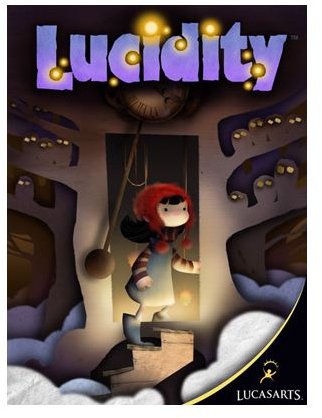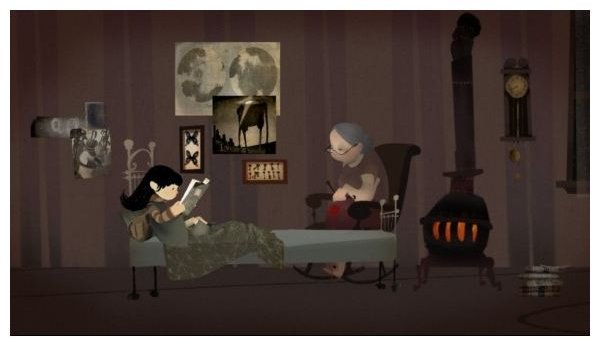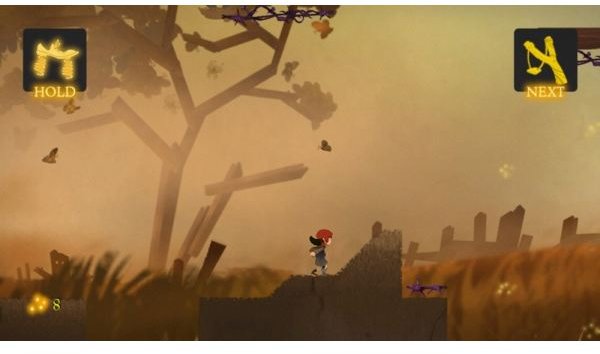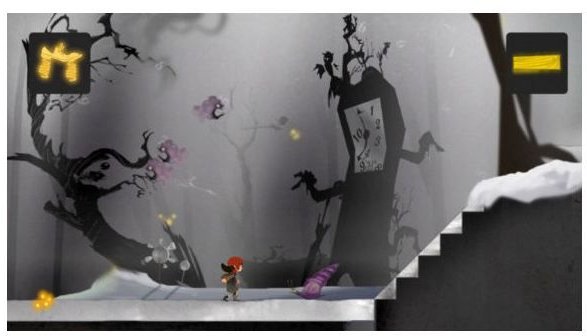Review of Lucasarts' New PC Game Lucidity

Story (3 out of 5)
Lucidity stars Sofi, a little girl who wanders through a series of surreal dreams in search of her missing grandmother. Each level begins with a childlike drawing and short text introduction from Sofi, and the end of each level reveals a postcard from her grandmother. These drawing and postcards are used to flesh out an otherwise simple, albeit charming story. For the most part they’re effective, although sometimes they try too hard to be cutesy and heart-warming and end up coming across as mildly nauseating instead. Beyond a few instances of too much fuzziness it’s easy to sympathize with Sofi and her quest, even if it’s nothing we haven’t seen before.
Gameplay (3 out of 5)
Instead of being controlled directly Sofi slowly walks through the dreamworld on her own as you manipulate her path using items. These items come to you at random, although you get a preview of what’s coming next so you can plan your route based on that info. You can put one item in reserve to swap back in whenever you like, but beyond that you’re stuck with whatever luck throws your way. While the basic goal is just to get to the end of the level, you’re also encouraged to collect fireflies along the way. Collecting them in large numbers unlocks bonus levels, and they also heal Sofi when she takes a hit from an enemy. It’s pretty much impossible to get all of a level’s fireflies in a single go, which gives you reason to revisit each stage a few times.

The variety of items is small, which at first makes the gameplay pretty simplistic. The challenge of collecting fireflies negates this somewhat, but unfortunately the gameplay still has its flaws. The biggest problem is the random distribution of items, which at times can be very frustrating. While it’s not always an issue, it can sometimes force you to miss the path you wanted to take, or lead to your death, through no fault of your own. For example, you may wish to use a stairway to reach a higher path, but you receive nothing but a series of horizontal beams. Or you may be approaching a group of enemies without a bomb to kill them, forcing you to wildly place items in the hopes that a bomb will come up before Sofi meanders into her own demise. Most of the time you can improvise your way through the randomness, which is part of the game’s challenge. But when that same challenge results in cheap deaths, a problem compounded in the harder levels where pitfalls abound, it can become an incredibly infuriating experience.
Graphics (5 out of 5)
Lucidity’s biggest strength is its absolutely gorgeous art design. You’ll travel through a variety of areas, such as a forest, an underwater region and a cave system, and they all have a unique storybook feel to them. This is enhanced by the dreamlike quality of the levels, which makes each area you visit really stand out. The stages’ elaborately detailed backgrounds (and occasionally foregrounds) are the most memorable parts, as unfortunately the simple platforms that Sofi navigates and the surprisingly uninspired enemies that are encountered are a little dull in comparison.

The excellent visual design carries over to other areas of the game as well. The menus are well designed and fit the feel of the game, in particular the level select screen. Of special note are the aforementioned drawings by Sofi, which have a tendency to both be adorable and do an excellent job of setting the mood for the upcoming stage. While it can be argued that too much importance is sometimes placed on a game’s graphics, in Lucidity’s case they strongly enhance the look and feel of the game, giving it a uniqueness and charm it would lack with more mundane visuals.
Audio (4 out of 5)
The soundtrack complements the graphics nicely, offering up a good mixture of songs that fit the game’s atmosphere. They’re mostly slow paced, moody pieces, but a few more upbeat tunes are featured as well. For a relatively small game there’s an impressive variety of tracks, and most importantly they avoid getting repetitive, which is essential when players either get stuck on harder levels or replay them several times to collect all the fireflies. The music’s excellent job of enhancing the art style is definitely what makes Lucidity’s audio standout.

Dialogue is non-existent, meaning the only sound you’ll hear from Sofi are squeaks and squeals, either in sporadic cut scenes or as she climbs, takes hits from enemies or encounters other obstacles. Enemies are vocal as well, having a tendency to growl and hiss at Sofi as she draws near. None of the sound effects really stand out, but they do a decent enough job of adding noise to the game. Not hearing more from Sofi feels like a bit of a lost opportunity though; perhaps having her read the text introduction for each level or something along those lines would have added to her character and made the audio more memorable.
Conclusion (4 out of 5)
Lucidity starts out as a beautiful experience, but sooner or later that experience is marred by gameplay flaws. As a result, it’s tough to simply say yes or no to the question of whether this game is worth your time and money. If the visual design intrigues you and you don’t mind putting up with some frustrating moments then it’s definitely worth a try. However, if you find simple gameplay to be off-putting and are easily infuriated by cheap deaths then this might not be the game for you. Perhaps the single best argument in favor of playing Lucidity is its price; for just ten dollars you get a fair amount of content, especially if you’re willing to replay the most frustrating portions of the game in order to collect fireflies. Ultimately the sheer charm and exquisite atmosphere will be worth the price of admission for most gamers, even if that charm is sometimes ruined by frustration.
